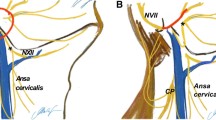Summary
A satisfactory long term result was obtained in 19 out of 25 cases of facial paralysis, consequent upon complete removal of an acoustic neurinoma, by anastomosis of the facial nerve, in 24 cases with the spinal accessory and in 1 case with the hypoglossal nerve. The technique ofBragdon andGray whereby the deep branch of the spinal accessory nerve is spared and only the superficial branch is used for the anastomosis has proved to be of great value.
Zusammenfassung
Aus einem Kollektiv von 25 Fällen mit Fazialislähmung nach Entfernung eines Akustikusneurinomes, bei denen 24mal eine Fazialis-Akzessoriusana-stomose und lmal eine Fazialis-Hypoglossusanastomose ausgeführt worden war, konnten 19 Fälle ausreichend lange nachuntersucht werden. Die Technik vonBragdon undGray, bei der die tiefen Äste des spinalen Akzessorius erhalten bleiben und nur der oberflächliche Nerventeil zur Anastomose verwendet wird, hat sich gut bewährt.
Résumé
Un résultat satisfaisant à long terme a été obtenu dans 19 cas sur 25 de paralysie faciale après l'extirpation complète du neurinome de l'acoustique en anastomosant le nerf facial dans 24 cas avec le spinal et dans 1 cas avec l'hypoglosse. La technique de Bragdon et Gray nous a donné satisfaction; elle consiste à anastomoser la branche superficielle du spinal et à préserver sa branche profonde.
Riassunto
Vengono riferiti gli esiti a distanza di 25 casi di anastomosi (24 spino-facciali e 1 ipoglosso-facciale) con risultato soddisfacente in 19 (76%). Si dimostró molto utile la tecnica di Bragdon e Gray secondo la qua le il ramo profondo del nervo accessorio spinale viene diviso e solo il ramo superficiale viene adoperato per l'anastomosi.
Resumen
Los resultados obtenidos en 25 casos de parálisis facial, después de la extirpación completa de neurinomas del acústico, fueron satisfactorios en 19 enfermos coh un largo periodo de observación. Se realizó una anastomosis espino-facial en 24 casos y en 1 caso con el nervio hipogloso. La técnica de Bragdon y Gray, con la cual la rama profunda del nervio espinal accesorio es respetada, usando solamente la rama superficial para la anastomosis ha resultado muy valiosa.
Similar content being viewed by others
References
Ballance, C., andA. B. Duel, The operative treatment of facial palsy by the introduction of nerve graft into the falloppian canal and by other intratemporal Arch. Otolaryng. Chicago15 (1932), 1–70.
Bragdon, F. H., andG. H. Gray, Jr., Differential spinal accessory-facial anastomosis with preservation of function of trapezius. J. Neurosurg.19 (1962), 981–985.
Cecotto, C., Tumori dell'acustico. Trattamento chirurgico della paralisi post-operatoria del facciale. Min. Neurochir.1 (1957), 106–108.
Coleman, C. C., andJ. C. Walker, Technic of anastomosis of the branches of the facial nerve with the spinal accessory for facial paralysis. Ann. Surg.131 (1950), 960–966.
Dott, N. M., Facial paralysis restitution by extra-petrous nerve graft. Proc. Roy. Soc. Med.51 (1958), 900–902.
Drake, C. G., Acoustic neuroma. Repair of facial nerve with autogenous graft. J. Neurosurg.17 (1960), 836–842.
Hardy, R. C., G. Perret, andR. Meyers, Phrenico-facial nerve anastomosis for facial paralysis. J. Neurosurg.14 (1957), 400–405.
Horrax, G., andJ. L. Poppen, The end results of complete versus intra-capsular removal of acoustic tumors. Ann. Surg.130 (1940), 567–575.
Lodge, W. O., etS. A. Gueukdjian, De la paralysie faciale. Modifications des opérations d'anastomose facio-hypoglosse et de plastie faciale. Presse Med.63 (1955), 1025–1026.
Loew, F., Die kombinierte intrakranielle-extratemporale Fazialisplastik nachDott. Langenbecks Arch. Klin. Chir.298, 934–935, und Saarl. Ärzteblatt9 (1962).
Love, J. G., andB. W. Cannon, Nerve anastomosis in the treatment of facial paralysis. Special consideration of the etiologic role of tumors of the acoustic nerve. Arch. Surg. Chicago62 (1951), 379–390.
—, Surgical treatment of facial paralysis. A modification of spino-facial anastomosis. Proc. Mayo Clinic37. (1962), 404–405.
McKenzie, K. C., andE. Alexander, Jr., Restoration of facial function by nerve anastomosis. Ann. Surg.132 (1950), 411–415.
Morello, G., Chirurgia dei nervi facciale e intermediario. Min. Neurochir.1 (1957), 75–82.
Watson, andE. Williams, Glossopharyngeal-facial nerve anastomosis. Proc. Roy. Soc. Med.20 (1927), 1439–1442.
Author information
Authors and Affiliations
Rights and permissions
About this article
Cite this article
Migliavacca, F. Facial nerve anastomosis for facial paralysis following acoustic neurinoma surgery. Acta neurochir 17, 274–279 (1967). https://doi.org/10.1007/BF01404572
Issue Date:
DOI: https://doi.org/10.1007/BF01404572




